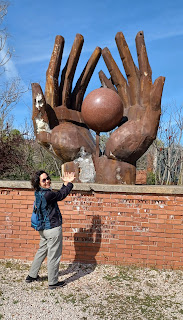After six nights in Budapest, we rented a car and headed into the Hungarian countryside to explore two of Hungary's wine regions. Before driving to our first destination, we stopped outside Budapest at Memento Park, a site dedicated to monuments from Hungary's Communist period. The first thing we saw was a vintage Trabant, a car made by East Germany from 1957-1991. Performance was clearly not the goal, as the car is listed as going from 0 to 100 km/h (about 62 mph) in 21 seconds.
The monuments mostly were dedicated to workers or soldiers. Of course, Lenin had a strong presence too. As you can see below, they are generally of very large stature.
The park also contains an interesting exhibit about the events leading up to the 1989 fall of Communism, which definitely helped add to our understanding of the country's history. It's terrific that Hungary had the foresight to preserve these items and use them in an educational manner. There were cheeky references to the failures of the Soviet system.
We headed to the city of Eger, which also gives its name to one of Hungary's 22 wine districts. Eger turned out to be a really great little city with a significant part in Hungarian history. First, it has a lovely Basilica, which was very close to the apartment we rented. It was free to enter, in contrast the the large churches in Budapest.
Second, the city has a nice central plaza with an old statue of Istvan Dobo, the most important person in Eger's history (more on him below), along with a lovely city hall, and a modern fountain that we suspect is very popular in the hot Hungarian summers.
Finally, the castle is renowned. During the wars between Hungary and the Ottoman Empire, Eger was near the border between the two and was the site of several important battles. In 1552, an attack by the Turkish armies on Eger Castle was successfully defeated by Captain Istvan Dobo and a small number of soldiers under his command. This successful battle became a central moment in Hungarian history in part through a novel written about it in the late 1800's (and movie of the novel released in 1968):
Eclipse of the Crescent Moon, which remains one of the best-known novels in Hungary. This battle did mostly destroy the castle, which was then rebuilt in its current form. The battle also created the mythical name for one of Eger's best known red wine's: bull's blood.
Unfortunately, Dobo's 1552 victory was short lived. The Turks returned in 1596 and took the rebuilt castle, which initiated a period of 91 years of Ottoman rule. As in the rest of Hungary, very little remains from this period, but the minaret from one of the city's mosques survived.
Near Eger, we did two excellent tastings at St. Andrea Winery and Bolyki Winery & Vineyards, which were very different, but demonstrated to us that the region makes very good wines at many price points. We learned that during the Communist period, Hungary made a lot of low-quality wine to serve the Communist "market" for all of the Soviet-bloc countries. Since 1989, the industry has been privatized and many small vineyards are making wines of much higher quality, but because of the limited production, they are not easily avaiable outside of Hungary.
After leaving Eger, we drove to the Tokaj (pronounced "To-kai") region, which is probably the most famous wine region in Hungary. The initial mention of this region was in a document from 1413, and Louis XIV described their sweet Aszu wines as "the wine of Kings, the king of wines."
On our first night in the Tokaj area we had a lovely dinner at the elegant Sauska winery, which provided great views of the surrounding countryside.
.jpg)
The next day, we did a tasting at Disznoko, which was recommended by Tomas, the sommelier at dinner our first night in Budapest. The vineyards are beautiful, and we had a great day to walk in them.
The winery is quite large, and we saw their impressive collection of older bottles. The tasting itself was done in a natural wine cellar, and, although we generally prefer dry wines, we were very impressed with the famous sweet wines of the region.
We did not stay in the small city of Tokaj, but took some time to visit. Clearly wine tourism is a central part of the draw of the town.
On our drive back to the city of Sarospatak where we stayed, we stopped at a series of wine cellars that were built into a hill near Tokaj hundreds of years ago. Many of them have been owned by families for generations, while some are owned by wineries. We entered one of the latter and try a bit of wine with an employee who was from Michigan (of course). That cellar was quite impressive, including a beautiful stained-glass window.
Finally, the town of Sarospatak also had a castle, but it was much less impressive than the one in Eger (and less historically important). Essentially we did very little in town other than take a walk around the castle grounds as almost everything was closed on Palm Sunday.
Shana couldn't resist getting a photo at each sign, which certainly ensure you remember where you were.
And that concludes our visit to Hungary. We returned to Budapest and dropped the car before catching a train to Vienna from where we flew back to Bilbao. However, we did not immediately return home as we planned to meet friends in the Rioja region for more wine (and food).
More about that soon.
Jeff and Shana















.jpg)



.jpg)






























